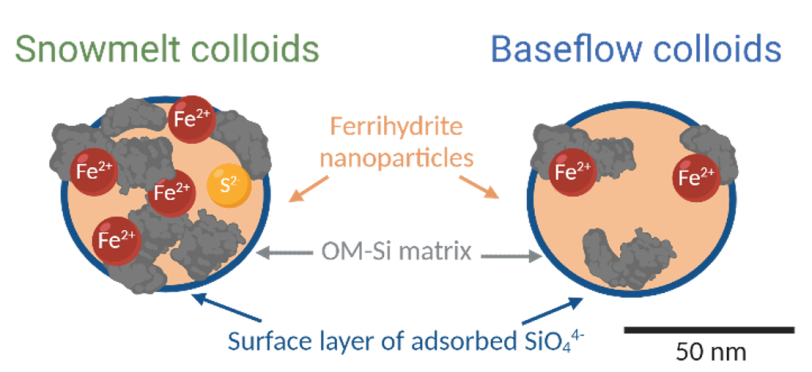Characterization of Natural Ferrihydrite Nano-Colloids from a Redox-Active Floodplain
By

The Science
Colloids can transport nutrients, contaminants, and organic matter throughout watersheds. Their persistence, reactivity and heterogeneous compositions renders them key contributors to biogeochemical reactions. We detected Fe-rich colloids in anoxic groundwater of a redox-active floodplain by Slate River, CO. The colloids were characterized by a wide array of techniques (e.g., cryo-TEM, TEM-EDS, Mössbauer spectroscopy, and Fe-EXAFS) and were found to be mixed-phase assemblages composed of Si-coated and organic matter enmeshed ferrihydrite nanoparticles. The fact that both Fe(II) and Fe(III) co-existed in the colloids under anoxic conditions, illustrates the passivating effects of the Si and organic matter matrix against redox triggered transformations.
The Impact
The ability of ferrihydrite-based colloids to withstand anoxic conditions rich in dissolved Fe(II) highlights the extent to which organic matter-Si coatings can protect Fe(III) from reductive dissolution. This passivating feature may also explain the existence of Fe(II) and S within the colloidal structure. Ultimately, the persistence of the colloids suggests they may transport throughout anoxic zones and reach oxic surface waters. Our findings shed light on the composition and dynamics of natural Fe-rich colloids in floodplain systems, with implications to elemental transport and cycling.
Summary
Subsurface interfaces are ubiquitous in floodplain environments and sustain a multitude of biogeochemical processes, including the formation and release of reactive, mobile colloids. Colloids are known vectors of micronutrient, contaminant, and organic matter transport and are suspected to be important export agents from floodplains to stream water. However, few studies have characterized naturally occurring Fe-rich colloids at the molecular scale.
We used a combination of advanced characterization techniques to decipher the composition of Fe-rich colloids at our floodplain field site of Slate River, CO. Cascade filtering revealed the presence of Fe-rich colloids in the riparian anoxic soil water and their abundance and composition varying with season. Cryo-EM and TEM-EDS imaging showed mono-dispersed and nano-assemblages of spherical colloids in the 10-50 nm range containing Fe, O, Si, C, and Ca. TEM selected-area electron diffraction analysis and Mössbauer spectroscopy indicated a poorly crystalline ferrihydrite-like phase. Fe-EXAFS further verified ferrihydrite and Fe(II)- and Fe(III)-organic matter interactions, as well as a small contribution from Fe-S bonding. We therefore conclude the colloids are primarily composed of nanosized ferrihydrite spheres that are stabilized by organic matter, Si, and bridging cations (e.g., Ca). The fact that these Fe(III)-rich colloids existed in primarily anoxic zones is striking. We postulate that the Si-organic matter coating serves as a passivating layer against reduction, but its efficiency likely depends on the biogeochemical and hydrological conditions.
Contacts
Kristin Boye
SLAC National Accelerator Laboratory
Funding
The project was conceived and supported by the SLAC Floodplain Hydro-Biogoechemistry
Science Focus Area project funded by the Earth and Environmental Systems Sciences Division of
the U.S. Department of Energy’s (DOE) Office of Science Biological and Environmental Research
(BER) Program under contract no. DEAC0276SF00515SBR (SLAC National Accelerator
Laboratory).
Publications
Engel M., Noël V., Pierce S., Kovarik L., Kukkadapu R., Lezama Pacheco J., Qafoku O., Runyon R., Chorover J., Zhou W., Cliff J., Boye K. and Bargar J. (2023) Structure and composition of natural ferrihydrite nano-colloids in anoxic groundwater. Water Research. 238 (119990). https://doi.org/10.1016/j.watres.2023.119990
